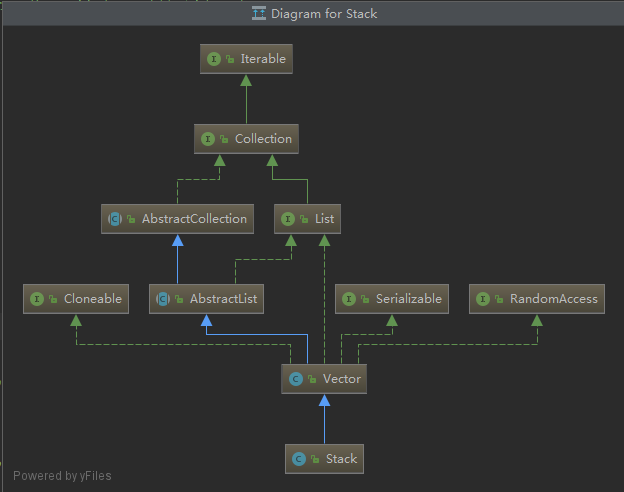jdk1.8-stack 栈源码分析

public
class Stack<E> extends Vector<E>
分析:栈的继承关系很简单,就是继承了Vector,那么我们可以猜测栈操作大部分应该是线程安全的。
/**
* Creates an empty Stack.
*/
public Stack() {
}
/**
* Pushes an item onto the top of this stack. This has exactly
* the same effect as:
* <blockquote><pre>
* addElement(item)</pre></blockquote>
*
* @param item the item to be pushed onto this stack.
* @return the <code>item</code> argument.
* @see java.util.Vector#addElement
*/
public E push(E item) {
//调用父类vector的addElement()方法
addElement(item);
return item;
}
分析:往栈里压入一个元素用push方法,每次往栈的顶部压入元素。addElement()是抽象父类vector方法,我们在vector里已经分析过。从这里我们可以知道,栈的底层数组结构也是数组。
/**
* Removes the object at the top of this stack and returns that
* object as the value of this function.
*
* @return The object at the top of this stack (the last item
* of the <tt>Vector</tt> object).
* @throws EmptyStackException if this stack is empty.
*/
public synchronized E pop() {
E obj;
//栈的长度
int len = size();
//栈顶部的元素值(也就是数组最后一个元素值)
obj = peek();
//栈元素减1
removeElementAt(len - 1);
//返回顶部元素
return obj;
}
分析:删除栈顶部的对象,并将该对象作为函数值返回
/**
* Deletes the component at the specified index. Each component in
* this vector with an index greater or equal to the specified
* {@code index} is shifted downward to have an index one
* smaller than the value it had previously. The size of this vector
* is decreased by {@code 1}.
*
* <p>The index must be a value greater than or equal to {@code 0}
* and less than the current size of the vector.
*
* <p>This method is identical in functionality to the {@link #remove(int)}
* method (which is part of the {@link List} interface). Note that the
* {@code remove} method returns the old value that was stored at the
* specified position.
*
* @param index the index of the object to remove
* @throws ArrayIndexOutOfBoundsException if the index is out of range
* ({@code index < 0 || index >= size()})
*/
public synchronized void removeElementAt(int index) {
//修改次数加1
modCount++;
//校验是否越界
if (index >= elementCount) {
throw new ArrayIndexOutOfBoundsException(index + " >= " +
elementCount);
}
else if (index < 0) {
throw new ArrayIndexOutOfBoundsException(index);
}
//数组需要移动的个数
int j = elementCount - index - 1;
if (j > 0) {
//从index + 1位置开始,向左移动一个位置,移动的个数为j
System.arraycopy(elementData, index + 1, elementData, index, j);
}
//数组实际元素减1
elementCount--;
//数组最后一个元素置为null,等待gc回收
elementData[elementCount] = null; /* to let gc do its work */
}
分析:传进来len -1,栈顶部元素下标,即数组最后一个元素位置。
/**
* Looks at the object at the top of this stack without removing it
* from the stack.
*
* @return the object at the top of this stack (the last item
* of the <tt>Vector</tt> object).
* @throws EmptyStackException if this stack is empty.
*/
public synchronized E peek() {
int len = size();
if (len == 0)
throw new EmptyStackException();
//根据索引从数组里取值,elementAt是调用父类Vector的方法
return elementAt(len - 1);
}
分析:栈的peek()方法,其实就是返回栈顶部的元素值,即数组末尾元素值。
/**
* Returns the component at the specified index.
*
* <p>This method is identical in functionality to the {@link #get(int)}
* method (which is part of the {@link List} interface).
*
* @param index an index into this vector
* @return the component at the specified index
* @throws ArrayIndexOutOfBoundsException if the index is out of range
* ({@code index < 0 || index >= size()})
*/
public synchronized E elementAt(int index) {
if (index >= elementCount) {
throw new ArrayIndexOutOfBoundsException(index + " >= " + elementCount);
}
return elementData(index);
}
分析:这个方法就是根据下标,返回数组的值而已,没啥好分析的。

jdk1.8-stack 栈源码分析的更多相关文章
- Stack的源码分析和应用实例
1.Stack介绍 Stack是栈.它的特性是:先进后出(FILO:First In Last Out). java工具包中的Stack是继承于Vector(矢量队列)的,由于Vector是通过数组实 ...
- Java集合基于JDK1.8的LinkedList源码分析
上篇我们分析了ArrayList的底层实现,知道了ArrayList底层是基于数组实现的,因此具有查找修改快而插入删除慢的特点.本篇介绍的LinkedList是List接口的另一种实现,它的底层是基于 ...
- Java -- 基于JDK1.8的LinkedList源码分析
1,上周末我们一起分析了ArrayList的源码并进行了一些总结,因为最近在看Collection这一块的东西,下面的图也是大致的总结了Collection里面重要的接口和类,如果没有意外的话后面基本 ...
- JDK1.7之 HashMap 源码分析
转载请注明出处:http://blog.csdn.net/crazy1235/article/details/75451812 类继承关系 构造函数 Entry put put putForNullK ...
- Java -- 基于JDK1.8的ThreadLocal源码分析
1,最近在做一个需求的时候需要对外部暴露一个值得应用 ,一般来说直接写个单例,将这个成员变量的值暴露出去就ok了,但是当时突然灵机一动(现在回想是个多余的想法),想到handle源码里面有使用过Th ...
- Java集合基于JDK1.8的ArrayList源码分析
本篇分析ArrayList的源码,在分析之前先跟大家谈一谈数组.数组可能是我们最早接触到的数据结构之一,它是在内存中划分出一块连续的地址空间用来进行元素的存储,由于它直接操作内存,所以数组的性能要比集 ...
- 基于jdk1.8的ArrayList源码分析
前言ArrayList作为一个常用的集合类,这次我们简单的根据源码来看看AarryList是如何使用的. ArrayList拥有的成员变量 public class ArrayList<E> ...
- Java -- 基于JDK1.8的ArrayList源码分析
1,前言 很久没有写博客了,很想念大家,18年都快过完了,才开始写第一篇,争取后面每周写点,权当是记录,因为最近在看JDK的Collection,而且ArrayList源码这一块也经常被面试官问道,所 ...
- Stack&Vector源码分析 jdk1.6
参照:http://www.cnblogs.com/tstd/p/5104099.html Stack(Fitst In Last Out) 1.定义 public class Stack<E& ...
随机推荐
- Springboot整合Ehcache 解决Mybatis二级缓存数据脏读 -详细
前面有写了一篇关于这个,但是这几天又改进了一点,就单独一篇在详细说明一下 配置 application.properties ,启用Ehcache # Ehcache缓存 spring.cache.t ...
- dyld: Symbol not found: _OBJC_CLASS_$_xxxx 错误闪退
dyld: Symbol not found: _OBJC_CLASS_$_xxx 引起的APP闪退可以先查看xxx所属的库,然后将其设为optional 例如dyld: Symbol not fou ...
- 解决mysql提示服务无法启动问题
1.管理员权限打开命令,进入mysql下bin文件夹 删除根目录下data文件夹没有不用管,重新安装 2. ---------------------------------------------- ...
- Nginx location模块整理
location模块 Nginx location location 指令的作用是根据用户请求的URI来执行不同的应用,URI就是根据用户请求到的网址URL进行匹配,匹配成功了进行相关的操作. loc ...
- PHP基础教程-APACHE
兄弟连:如何配置APACHE.首先,安装并配置PHP3 1.解开压缩包到你喜欢的目录如:C:PHP3 2.把C:php3php3.ini-inst文件改名成PHP3.INI并拷贝到C:windows ...
- Qbxt 模拟赛&&day-8
/* 今天的题目还是比较不错的. 今天考的很烂还是依旧的弱. 快考试了加油吧. Bless all. */ 注:所有题目的时间限制均为 1s,内存限制均为 256MB. 1.第K小数 (number. ...
- ArrayList,LinkedList和String
import java.util.ArrayList; public class Demo{ public static void main(String[] args) throws Excepti ...
- 「HNOI2014」世界树
题目链接 问题分析 首先观察数据范围可以知道要用虚树.但是要考虑怎么维护原树的距离信息. 如果只有两个关键点,我们可以很方便地找到中点将整棵树划分为两部分.而如果有多个关键点,看起来有效的方法就是多源 ...
- HNOI2012矿场搭建
做完Mining Your Own Business后觉得这个题没什么意思了,数据范围小的连边数不清空都能A. 题解直接看这篇吧.做题的经历也挺……对吧. #include<iostream&g ...
- DB 分库分表的基本思想和切分策略
DB 分库分表的基本思想和切分策略 一.基本思想 Sharding的基本思想就要把一个数据库切分成多个部分放到不同的数据库(server)上,从而缓解单一数据库的性能问题.不太严格的讲,对于海量数据的 ...
